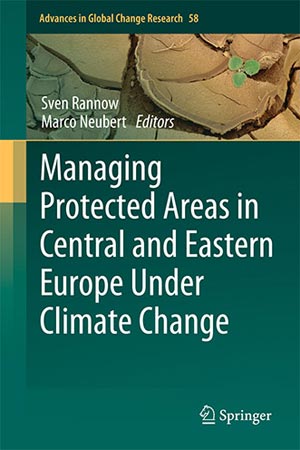Better protection for Europe’s protected natural areas: A manual shows possible ways

Front-Cover "Managing Protected Areas in Central and Eastern Europe under Climate Change" Source: Springer
Climate change and its effects on habitats and on the plant and animal worlds is one of the major challenges facing protected areas all over Europe. The management and protection strategies of national parks, nature parks and biosphere reserves must be adapted accordingly. To date however, these institutions have suffered from a lack of empirical data and recommendations for action.
This gap has now been bridged by the book Managing Protected Areas in Central and Eastern Europe under Climate Change. The seventeen research institutes, conservation authorities and protected area administrations in Central and Eastern Europe which have cooperated in the HABIT-CHANGE project have together developed a set of recommendations which constitute a practical guide for how the managements of protected areas can react to the challenges of climate change.
What has become clear in the cross-border research project is that in order to be able to implement climate adaptation measures, it will first of all be necessary to develop the capacities in the protected areas to monitor, assess, manage and report the effects of climate change and their interaction with other impact factors. Based on the data and methods gathered and processed during the three-and-a-half year duration of the project, the manual presents possible ways of achieving optimized protected area management.
Brief and illustrative examples from Central and Eastern European investigation areas show the effects of climate change locally, and what consequences this has for future management. The main emphasis here is on habitats which are particularly sensitive to changed climatic conditions. These include alpine areas, wetlands, forests, grasslands and coastal areas.
These case examples showed not only the potential use of adaptation measures, but also possible barriers to their practical implementation. With the presentation of examples, the book seizes upon important knowledge gained from the research project: It has been shown that the partners particularly profit from the exchange of their own experiences in protected area management – for different perspectives have again and again led to new solutions for particular protected areas.
The book is written in non-technical language for a broad spectrum of readers.
Reference:
Rannow, S. & Neubert, M. (eds): Managing Protected Areas in Central and Eastern Europe under Climate Change, Advances in Global Change Research, Vol. 58, Springer, Dordrecht, 308 p., DOI: 10.1007/978-94-007-7960-0 (ISBN 978-94-007-7959-4).
Contact:
Dr. Marco Neubert, phone: +49 351 46 79-274, e-mail: M.Neubert[at]ioer.de
Media Contact
All latest news from the category: Ecology, The Environment and Conservation
This complex theme deals primarily with interactions between organisms and the environmental factors that impact them, but to a greater extent between individual inanimate environmental factors.
innovations-report offers informative reports and articles on topics such as climate protection, landscape conservation, ecological systems, wildlife and nature parks and ecosystem efficiency and balance.
Newest articles

High-energy-density aqueous battery based on halogen multi-electron transfer
Traditional non-aqueous lithium-ion batteries have a high energy density, but their safety is compromised due to the flammable organic electrolytes they utilize. Aqueous batteries use water as the solvent for…

First-ever combined heart pump and pig kidney transplant
…gives new hope to patient with terminal illness. Surgeons at NYU Langone Health performed the first-ever combined mechanical heart pump and gene-edited pig kidney transplant surgery in a 54-year-old woman…

Biophysics: Testing how well biomarkers work
LMU researchers have developed a method to determine how reliably target proteins can be labeled using super-resolution fluorescence microscopy. Modern microscopy techniques make it possible to examine the inner workings…





















